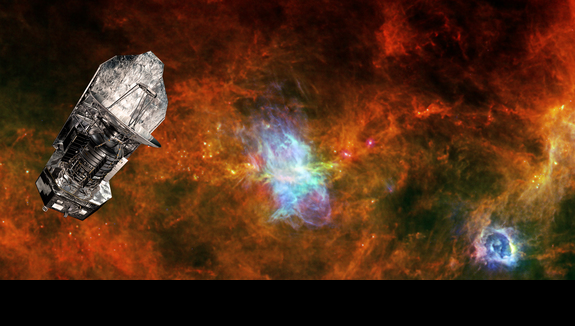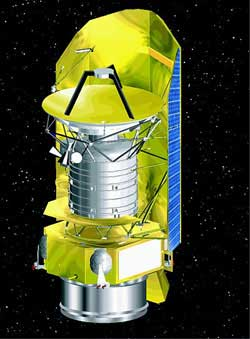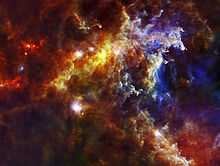The Herschel Space Observatory with the Vela-C Star-Forming Region in the Background Image Source
A large part of the universe is made up of gas and dust that is too cold to radiate in visible light or at shorter wavelengths such as X-rays. Most stars and cosmic objects that are hot enough to shine at optical wavelengths are often hidden behind these vast dust clouds that absorb the visible light and re-radiate it in the far infrared and submillimeter wavelengths. This portion of the spectrum is very important to astronomers because it is here that a large part of the universe radiates.
However, these wavelengths cannot be perceived by the human eye or observed by earthbound telescopes because most of this light is absorbed by the dust clouds before it becomes visible. Space-based observatories enable astronomers to observe these wavelengths and access the furthest reaches of the Universe.
Herschel was the first space observatory with the ability to observe the far infrared to the submillimeter wavelengths. Previous space-based infrared telescopes did not have the sensitivity possessed by Herschel’s large mirror telescope and its powerful detectors. Herschel provided a new window to study the cold and hidden infrared universe and learn how the universe formed and evolved to what it is today.
Herschel Space Observatory Photo Source
What Was The Herschel Space Observatory?
The Herschel Space Observatory was a space-based telescope operated by the European Space Agency (ESA) between 2009 and 2013. It is one of the largest and most ambitious space projects undertaken by ESA. In fact, it was the fourth cornerstone mission in ESA’s Horizon 2000 Science Programme. It is also one of the most powerful and sophisticated telescope ever launched into space.
Apart from ESA, NASA was also a key participant in this mission and took part in the design of the instruments and data analysis. Ten other countries collaborated in this mission.
At first, it was referred to as the Far Infrared and Sub-millimeter Telescope (FIRST). It was later renamed Herschel after William Herschel, the English astronomer behind the discovery of infrared radiation in 1800.
The Launch of the Herschel Space Observatory
The Herschel Space Observatory was launched on 14 May 2009 by an Ariane 5 rocket from the ESA’s spaceport in Kourou, French Guiana.
It settled at the L2 Sun-Earth Lagrange Point, which is 1.5 million kilometers from Earth and in the direction opposite to the sun. At this position, there is minimal interference from Earth and the telescope had the widest range of view.
The Herschel Space Observatory Satellite
The Herschel Satellite had four main components as follows:
The satellite’s telescope was a Ritchey Chretien Design Telescope with a primary mirror 3.5 meters in diameter. At the time, this was the largest single mirror ever built for a space telescope. It collected almost twenty times more light than any previous infrared space telescope and was powerful enough to see fainter objects and distinguish finer details.
The payload contained sophisticated science instruments including the Heterodyne Instrument for the Far Infrared (HIFI), a high-resolution spectrometer, a Photoconductor Array Camera and Spectrometer (PACS), a Spectral and Photometric Imaging Receiver (SPIRE) and their detectors. These instruments were designed to analyze the waveband collected by the telescope.
The cryostat that kept the detectors at temperatures near absolute zero to prevent the heat emitted by the spacecraft from interfering with the observations was also stored in the payload module.
The service module contained the electronics and communication instruments. On one side of the satellite was a sun shield that protected the payload from direct sunlight.
What the Herschel Space Observatory Did
The Herschel space observatory’s mission objectives were to study the formation of galaxies in the early universe, the evolution of galaxies, the formation of stars, the chemical composition of surfaces and atmospheres of solar system objects and the molecular chemistry across the universe.
Just like NASA’s Spitzer Space Telescope, the Herschel satellite studied the universe by measuring infrared light. However, Herschel was much more powerful and could detect longer wavelengths in the far-infrared and submillimeter ranges making it the first telescope to observe in the full 60-670 micron range. Its onboard instruments were sensitive to these wavebands.
It collected long wavelength radiation from objects in our galaxy, extragalactic objects that are billions of light years away as well as newborn galaxies.
Did The Herschel Space Observatory Accomplish Its Mission?
The Herschel satellite accomplished its objectives. It made observations and discoveries that contributed to understanding how life in the universe evolved. It revealed new discoveries about the earliest and most distant stars and galaxies, as well as those near our home in space and time. The telescope took a unique look at our solar system.
It discovered a vast hole of empty space originally believed to be a dark nebula. This discovery led to a new understanding on how newly forming star regions discard materials surrounding them.
Rosette Nebula Taken By Herschel Image Source
It confirmed that molecular oxygen exists in space, discovered the exceptional HFLS3 starburst galaxy and discovered that the water on Jupiter got there after the collision of Comet Shoemaker-levy 9 in 1994.
An Artist’s Impression of the HFLS3 starburst galaxy Image Source
The Mission Ended As a Success in 2013
The lifespan of the Herschel space observatory relied on the lifespan of the liquid helium coolant that kept the detectors cool. The satellite ran out of coolant and so the mission ended in 2013, as a success.




